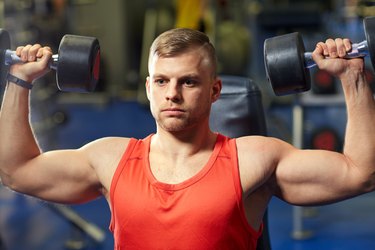
Millions of men and women worldwide enjoy weight training as a form of exercise. Shoulder impingement syndrome occurs when the tendon of the supraspinatus muscle gets pinched in the upper posterior shoulder. The origin of shoulder impingement syndrome is often poor upper body posture because of strength imbalances. Correcting the source of the poor posture with stretching and strengthening exercises lessens the symptoms, while employing perfect technique while lifting enables you to train and not aggravate the condition.
Anatomy
Video of the Day
The supraspinatus is the upper-most muscle of the rotator cuff group. It connects the shoulder blade, or scapula, to the upper arm bone, or humerus. The supraspinatus tendon runs through a narrow tunnel in the upper posterior shoulder. Inside this confined space is where the tendon becomes compromised and the symptoms are often felt.
Video of the Day
Posture
Poor posture and improper upper body mechanics created by strength imbalances lead to shoulder impingement by restricting the supraspinatus tendon's narrow passageway. If the internal rotator muscles of the shoulder (pectoralis major, subscapularis and latissimus dorsi) are overpowering the rotator cuff and the scapular retractor muscles, the shoulders will be rolled forward into bad posture. This poor position, along with forward carriage of the head, was named upper cross syndrome by functional anatomy expert Dr. Vladimir Janda. Upper cross syndrome leads to many upper body conditions, including shoulder impingement.
Implementation
Implement weight training exercises to strengthen the overpowered muscles and stretching exercises to lessen muscle tension and increase flexibility in the tight muscles. Correcting the strength imbalances will improve posture and lessen the impingement, thus eliminating the source of the pain.
Exercises
Perform weight lifting exercises such as rows, pulls, pulldowns and cleans with dumbbells, cables, a kettlebell or a barbell to strengthen the rhomboids and middle and lower portions of the trapezius muscles. You can also perform body-weight supine pull-ups, or inverted rows, to strengthen these muscles, which retract or pull the shoulder blades toward each other. Lessen or lay off training your chest and anterior shoulders for as long as it takes to correct your posture and restore correct movement patterns. Eliminate any exercise that increases your pain. Dr. Clay Hyght of Bodybuilding.com writes, "Barbell bench presses seem to exacerbate the condition once you have it." Execute the reverse pitch with light resistance to strengthen the rotator cuff muscles.
Technique
Be strict about proper technique when performing rows, pulldowns, pull-ups and the reverse pitch. When beginning the motion, pull your shoulder blades backward as if pinching the inner bottom corners of your scapulas together. This ensures proper positioning of your shoulder and begins correct muscle movement patterns. Stretch the internal rotators of the shoulders by executing several sets of the chin-up bar hang and the chest doorway stretch every day for 40 to 60 seconds.